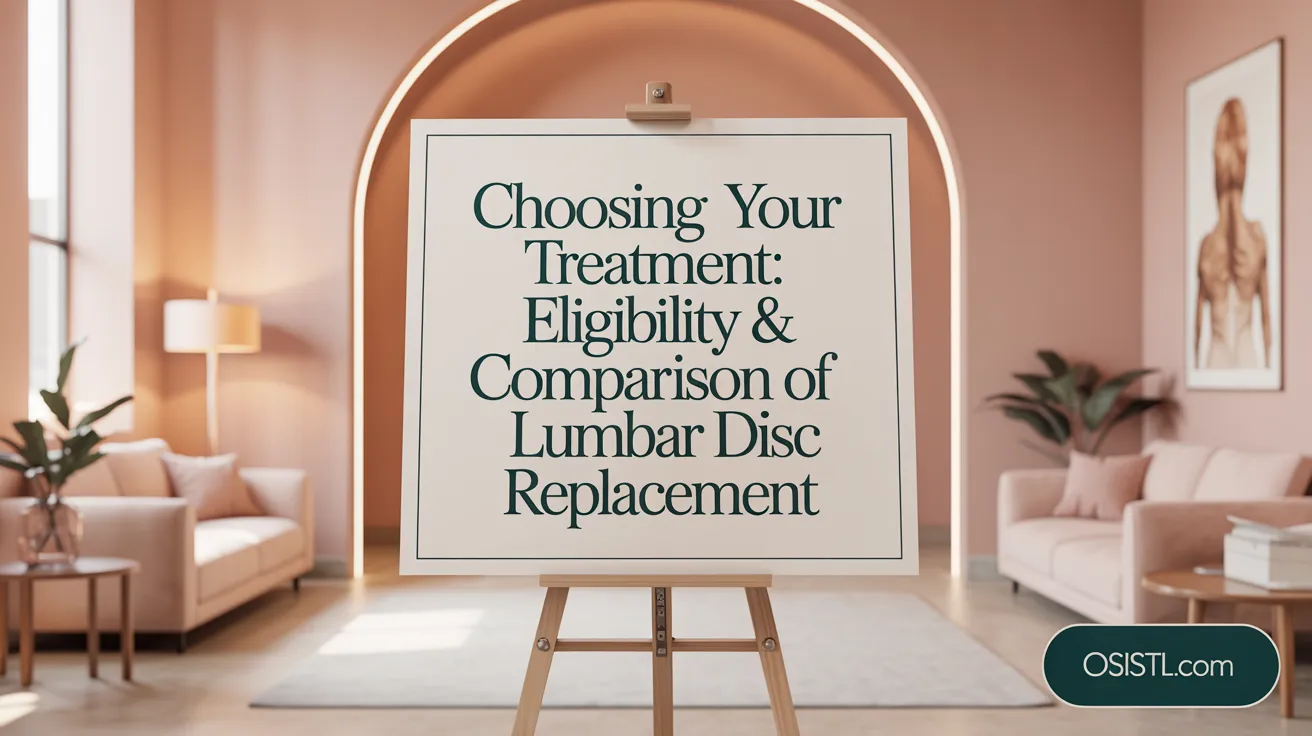An Overview of Lumbar Disc Replacement Surgery
Lumbar disc replacement surgery has emerged as a promising alternative to traditional spinal fusion for patients suffering from debilitating lower back pain caused by degenerative disc disease. By replacing damaged discs with artificial implants designed to preserve natural spinal motion, this procedure offers the potential for significant pain relief and improved quality of life. This article explores the key benefits, risks, patient eligibility, and recovery process associated with lumbar disc replacement, equipping readers with comprehensive knowledge to make informed treatment decisions or discussions with healthcare providers.
Benefits and Advantages of Lumbar Disc Replacement Surgery
 Lumbar disc replacement surgery offers numerous benefits of lumbar disc replacement for patients suffering from degenerative disc disease. Its primary goal is to alleviate pain relief for lumbar disc degeneration that results from damaged or worn discs.
Lumbar disc replacement surgery offers numerous benefits of lumbar disc replacement for patients suffering from degenerative disc disease. Its primary goal is to alleviate pain relief for lumbar disc degeneration that results from damaged or worn discs.
One of the significant advantages is the preserving spinal motion of natural spinal motion. Unlike spinal fusion, which permanently joins vertebrae and limits movement, lumbar disc replacement maintains the spine’s flexibility, which can help patients perform daily activities with less restriction.
Recovery times are generally shorter with lumbar disc replacement recovery. Most patients return to light activities within a week and resume full normal activities within approximately 3 months. Compared to fusion surgery, this results in a quicker overall recovery process.
Patients also experience an improvement in their quality of life improvement after the procedure. Pain relief is typically substantial, with studies showing that 80-90% of patients report significant reductions in back pain and enhanced mobility.
Another advantage is the reduced risk of adjacent segment degeneration. Because the procedure preserves anatomical motion, it decreases the stress on neighboring discs and vertebrae, potentially lowering the likelihood of future problems.
Lumbar disc replacement also minimizes the chances of requiring revision surgeries. Its design aims to last for decades, which diminishes the need for future operations related to implant failure or device wear.
Finally, the surgery helps maintain spinal height and overall function, preventing the collapse or deformities that can sometimes follow fusion procedures.
Overall, lumbar disc replacement is an effective and increasingly popular option that combines pain relief with the preservation of spinal function, leading to better long-term outcomes for suitable patients.
Potential Risks and Complications Associated with Lumbar Disc Replacement
 Lumbar disc replacement (LDR) is generally a safe and effective procedure for treating degenerative disc disease, but like any surgical intervention, it carries potential risks and complications.
Lumbar disc replacement (LDR) is generally a safe and effective procedure for treating degenerative disc disease, but like any surgical intervention, it carries potential risks and complications.
One of the most common concerns is the risk of infection after surgery. Symptoms such as redness, swelling, fever, or drainage at the surgical site may indicate an infection, which requires prompt medical attention to prevent further issues.
Another significant risk involves implant failure or dislocation. This can occur if the artificial disc loosens, migrates, or breaks, potentially leading to persistent pain, nerve compression, or the need for revision surgery.
Nerve and blood vessel injury are serious but rare complications. These may manifest as numbness, weakness, or vascular damage, particularly given the complexity of access through the anterior approach in lumbar surgery.
Additional challenges include complications like heterotopic ossification—abnormal bone growth outside the normal skeletal areas—which can restrict movement, and dural tears, leading to cerebrospinal fluid leaks and related neurological symptoms.
Clinical studies and adverse event reports highlight that these complications, though uncommon, are present in some cases. Implant subsidence, polyethylene dislodgement, and device handling issues are among the reported problems, with rates varying based on surgical technique and implant design.
Expertise of the surgeon plays a crucial role in minimizing these risks. Proper patient selection, meticulous surgical technique, and comprehensive preoperative planning are essential to reduce the likelihood of adverse outcomes.
Post-surgery, symptoms like persistent back or leg pain, numbness, swelling, or unusual bleeding can signal complications. Early detection and intervention are vital to improve outcomes and prevent more severe issues.
In all cases, patients should be fully informed about potential risks and closely follow post-operative care instructions to promote safe recovery. Regular follow-up appointments help monitor implant integrity and manage any emerging problems effectively.
Safety, Efficacy, and Long-term Outcomes of Lumbar Disc Replacement
 Lumbar disc replacement (LDR) has gained recognition as a motion-preserving alternative to traditional spinal fusion surgery. Comparatively, LDR is considered safe and effective for carefully selected patients, offering benefits such as maintained spinal mobility, reduced pain, and quicker recovery times.
Lumbar disc replacement (LDR) has gained recognition as a motion-preserving alternative to traditional spinal fusion surgery. Comparatively, LDR is considered safe and effective for carefully selected patients, offering benefits such as maintained spinal mobility, reduced pain, and quicker recovery times.
Success rates reported in several studies often exceed 80%, with many patients experiencing significant improvements in pain and functional ability. Long-term data, spanning up to 10-15 years, shows durable outcomes with sustained relief from symptoms. A large review involving nearly 1,200 patients indicated that most enjoy continued benefits, with low rates of reoperations (around 12%) and revisions over the years (Lumbar total disc arthroplasty clinical outcomes).
The durability of implants is an important consideration. Current evidence suggests that artificial discs can last for decades, with some estimates projecting lifespans of up to 40-70 years (Longevity of Artificial Discs). This long-term stability contributes to high patient satisfaction and reduced need for subsequent surgeries.
Clinical results from multi-year studies demonstrate that lumbar total disc replacement can diminish pain levels significantly, with many patients reporting more than 50% reduction in pain scores over time. Moreover, the preservation of natural spine movement reduces stress on adjacent segments, potentially decreasing the risk of adjacent segment disease (Natural Motion Preservation in Spinal Surgery).
Although promising, ongoing research aims to address certain gaps, including understanding the long-term effects on adjacent discs and nerve function, as well as improving implant designs to minimize wear and migration. Overall, lumbar disc replacement remains a viable option with favorable safety and durability profiles, especially when performed on suitable candidates.
Recovery Process and Post-Operative Care After Lumbar Disc Replacement
 After lumbar disc replacement surgery, patients usually spend a few days in the hospital for close monitoring and initial recovery. During this hospital stay, pain management is a priority, with most patients receiving medications to control discomfort and prevent infection. Postoperative pain can often be managed with over-the-counter medications like acetaminophen or ibuprofen, with some cases requiring short-term opioids.
After lumbar disc replacement surgery, patients usually spend a few days in the hospital for close monitoring and initial recovery. During this hospital stay, pain management is a priority, with most patients receiving medications to control discomfort and prevent infection. Postoperative pain can often be managed with over-the-counter medications like acetaminophen or ibuprofen, with some cases requiring short-term opioids.
Once discharged, patients begin physical therapy after artificial disc replacement relatively early to promote healing, regain strength, and improve flexibility. Activities are gradually increased, with most patients able to resume light daily tasks within 1 to 2 weeks. Physical therapy typically continues for several weeks, focusing on gentle exercises and mobility training.
Patients are advised to avoid heavy lifting, twisting, and high-impact activities for at least 4 to 6 months post-surgery. During the first few weeks, walking is encouraged as it helps maintain blood flow and supports healing. Full recovery, which includes returning to normal work and sports activities, generally takes about 3 to 6 months, although individual timelines can vary depending on overall health and adherence to post-surgical guidelines.
Follow-up care involves scheduled visits with the surgeon, usually at 2 weeks, 6 weeks, and several months after the procedure. During these visits, imaging tests for disc replacement may be performed to ensure proper implant positioning and healing progress. Monitoring for symptoms like persistent pain, swelling, fever, or neurological issues is crucial for early detection of potential complications.
Patients should follow all precautions advised by their healthcare providers, including restrictions on heavy lifting, bending, or twisting. Adopting healthy lifestyle habits like smoking cessation, maintaining a balanced diet, and engaging in recommended exercises can support long-term success of the implant. Typical symptoms during recovery include mild soreness, localized swelling, or tiredness, which usually resolve within a few days to weeks.
Patient Eligibility and Comparison with Other Treatment Options

How does lumbar disc replacement compare with other treatment options, such as spinal fusion, in terms of benefits and risks?
Lumbar disc replacement (LDR) offers several advantages over traditional spinal fusion. It preserves the natural motion of the spine, which can reduce the risk of adjacent segment disease—a condition where segments next to the surgery site degenerate faster due to altered biomechanics. Recovery times are generally shorter with LDR, often allowing patients to return to normal activities within a few weeks, whereas fusion may require a longer healing process.
However, LDR comes with its own set of risks, including device dislocation, implant failure, or heterotopic ossification. Fusion, on the other hand, results in a permanently fused segment, limiting movement and potentially leading to increased stress on adjacent discs, which can cause further degeneration. Patient selection is critical; not everyone with degenerative disc disease is suitable for this procedure.
The choice between LDR and fusion depends on individual health factors, the severity of disc degeneration, and the presence of spinal instability or deformities. Both options have similar complication rates and success in pain relief, but LDR’s motion-preserving feature provides long-term functional benefits. For detailed comparisons of outcomes and hazards, see Lumbar disc replacement versus interbody fusion and Risks and Challenges of Artificial Disc Replacement.
What are the eligibility criteria and indications for undergoing lumbar disc replacement?
Ideal candidates for lumbar disc replacement are typically adults experiencing chronic lower back pain primarily caused by degeneration of one or two lumbar discs (most commonly at L4-L5 or L5-S1). To be suitable, patients should have not improved after at least six months of conservative treatments like physical therapy, medications, or injections. For more on candidacy, visit Candidates for artificial disc surgery or Good candidate for spinal disc replacement.
Candidates should have good overall health without significant spinal instability, deformity such as scoliosis, or severe osteoporosis. They must also not have extensive facet joint arthritis, as this can affect outcomes.
Preoperative evaluation involves thorough diagnostics, including MRI or CT scans to confirm disc degeneration, and sometimes discography or epidural injections to pinpoint pain sources. Such assessments help ensure appropriate surgical candidacy and increase the likelihood of successful outcomes. For preoperative and evaluation details, see Preoperative Assessment for ADR and Pre-surgical evaluation for ADR.
In summary, lumbar disc replacement is a minimally invasive, motion-preserving option best suited to carefully selected patients who meet specific clinical criteria, ultimately offering significant pain relief and functional improvement with fewer long-term complications compared to traditional fusion surgeries. For an overview of procedure and recovery, refer to Lumbar disc replacement surgery overview and Recovery after artificial disc surgery.
Technological Advances and Future Directions in Artificial Lumbar Disc Replacement
Recent developments in artificial lumbar disc replacement (ALDR) focus on enhancing implant functionality, surgical procedures, and longevity. Advances in implant materials, such as high-quality metal alloys, polyethylene, and ceramics, have led to devices that more closely replicate the natural movement and shock absorption of healthy discs. These innovations aim to improve durability and reduce wear-related failures.
Minimally invasive surgical techniques have become more refined, enabling surgeons to insert artificial discs through smaller incisions. This results in less tissue damage, quicker recovery, and shorter hospital stays. Techniques utilizing real-time imaging guidance and advanced instrumentation are further pushing the boundaries of precision and safety.
Progress in motion preservation and shock absorption is ongoing. While current FDA-approved implants preserve bending and rotating functions, they still lack the natural shock absorption capabilities of real discs. Researchers are exploring new designs and materials that can better mimic shock absorption, potentially reducing stress on adjacent segments.
Long-term implant performance remains a focus of research. Studies are increasingly looking at the durability of prosthetic discs over decades, with some evidence suggesting lifespan up to 70 years. This ongoing research helps improve device design and predict long-term outcomes, providing patients with more confidence in the procedure.
Another exciting area is the potential for biologic disc regeneration. Scientists are examining tissue engineering and regenerative medicine techniques to develop biological therapies that could repair or replace degenerated discs naturally, potentially reducing the need for artificial implants.
Furthermore, ongoing studies and innovations aim to refine spinal surgery technology. These include advanced robotics, artificial intelligence (AI) integration for surgical planning, and improved biomaterials.
In summary, technological advances in implant materials, minimally invasive surgeries, motion preservation, and biologic therapies are shaping a promising future for ALDR. These innovations aim to enhance patient outcomes, prolong implant lifespan, and potentially offer biological solutions to disc degeneration.
Making Informed Decisions About Lumbar Disc Replacement
Lumbar disc replacement offers a valuable surgical option for select patients suffering from degenerative disc disease, promising pain relief, preservation of spine mobility, and faster recovery relative to spinal fusion. While the procedure carries potential risks such as infection and implant-related complications, advances in technology and careful patient selection have improved safety profiles and outcomes. Long-term studies support its efficacy and durability, with many patients experiencing lasting improvements in function and quality of life. Ultimately, a thorough evaluation by spinal specialists, consideration of individual health factors, and open dialogue about all treatment alternatives are essential for achieving the best results in spine care.
